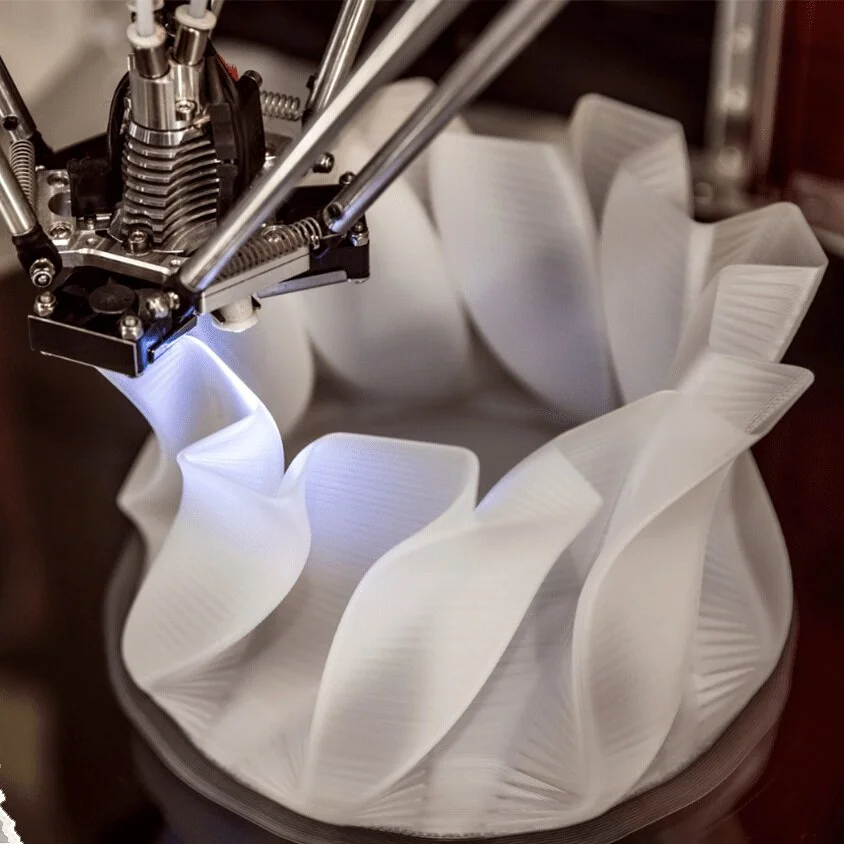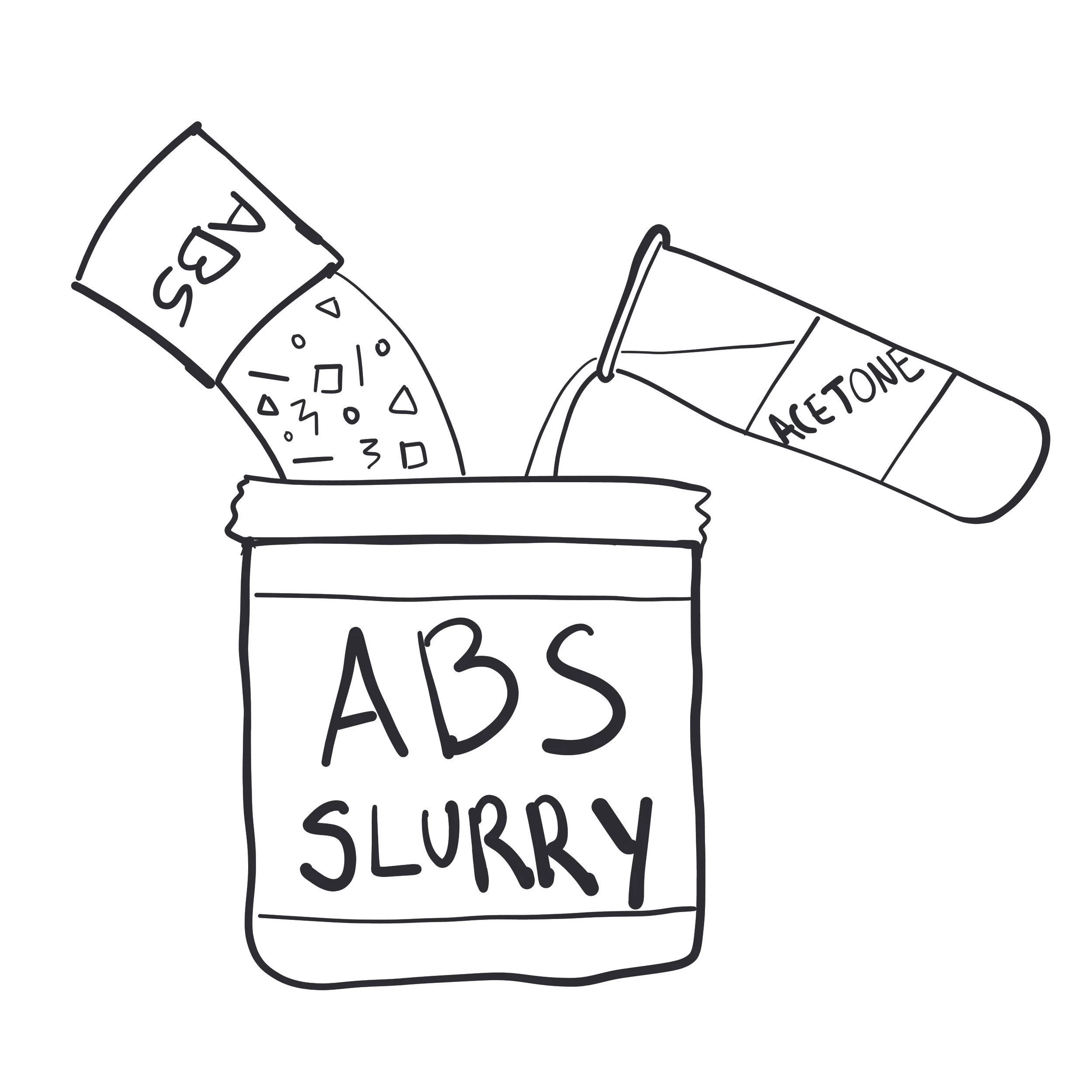HIPS Quick Start Guide
Quick Start Guide:
HIPS Filament
Overview
High Impact Polystyrene (HIPS) is a lightweight, impact resistant variant of Polystyrene (PS).
As a 3D printing material, HIPS makes for a fantastic soluable support material when printing ABS (or ASA) due their shared printing temperatures and HIPS’s solubility in d-limoline. Using HIPS in this way allows for otherwise impossible models to be printed as the support material simply dissolves upon submersion in limoline . The use of soluable support material also makes support material a breeze and results in models with smooth support interface layers.
HIPS also produces parts that are lightweight, durable with comparable performance to ABS.
As a form of Polystyrene (PS), HIPS also has one of the rare distinctions of being one of the few 3D printing materials available that are able to be curbside recycled in Australia.
While the same 3D printing equipment is required to print HIPS as ABS, (a heated bed and an enclosure) HIPS tends to be more forgiving as it experiences decreased warping, making it more forgiving to print for beginners.
For more information on what HIPS is and what it’s good for, check out our Introduction to HIPS Filament.
Pros |
Cons |
|||||
|---|---|---|---|---|---|---|
| ✔️ | Impact resistant | ❌ | Requires heated build plate & enclosure | |||
| ✔️ | Soluble in d-Limonene | ❌ | Requires ventilation while printing | |||
| ✔️ | Lightweight | |||||
Hardware Requirements
|
Enclosure |
Heated Bed |
Hardened |
Fan |
|
|
|
|
|
| ✔️✔️ | ✔️✔️ | ✖️ | ✔️✔️ |
|
Fume |
Direct |
High Temp |
Filament |
|
|
|
|
|
| ✔️✔️ | ✖️ | ✖️ | ✔️ |
Printing Settings
When printing in HIPS, provided you have a heated bed and an enclosure for your 3D printer, use the following settings for best results:
Extruder Temperature
-↓ Extruder Temperature ↓ Stringing - Will decrease at temperatures <240°C as the molten filament will have a higher viscocity, leading to a neater print. ↓ Oozing - See above. ↑ Underextrusion - Can happen at temperatures of <230°C as your printer simply can't melt the filament fast enough to keep up with the filament feed rate. Our tip: Before adjusting your extruder temperature any lower than <220°C, try adjusting your retraction, coasting and travel speed. |
220°C-240°CSet your extruder temperature to 220°C. Increase the printing temperature if you are experiencing underextrusion or if your extruder gear is slipping. 🛈
|
+↑ Extruder Temperature ↓ Surface Resolution- At temperatures of <240°C leading to sloppy layers |
Bed Temperature
-↓ Bed Temperature ↓ Part Adhesion - Too little heat in the bed will cause your part to cool to quickly, curl and dislodge from the bed. |
100 - 120°CsSet your bed temperature to 100°C for your first layer to ensure your first layer sticks to the bed and 75°C for the rest of the print. 🛈
|
+↑ Bed Temperature ↑ Part Deformation - Too much heat will cause your part to melt into the bed, deforming the bottom layers. |
Fan Speed
-↓ Fan Speed ↑ Part Strength - Slows the cooling rate of each layer being printed. This gives the part more time to bond to the preceeding layer, resulting in increased interlayer adhesion and part strength. Helps remedy part delamination problems. HIPS can be printed with fan speed set to 0%. ↓ Surface Resolution - Decreasing the fan speed will result in your HIPS staying more molten for longer. This can result in sloppy layer lines. |
20-30%Start at 20% fan speed for a good balance between part strength and surface resolution 🛈
|
+↑ Fan Speed ↓ Part Strength - Increases the cooling rate of each layer being printed. This gives the part less time to bond to the preceeding layer, resulting in less interlayer adhesion and a decrease in part strength. |
Print Speed
-↓ Print Speed | ↑ Print Time ↑ Layer Adhesion - Gives your layers more time to bond, increasing interlayer adhesion. ↑ Part Deformation - Too much thermal energy may be pumped into your part, slowing down the cooling and resulting in sloppy layers ↓ Travel Speed | ↑ Print Time ↑ Stringing - More time spent travelling results in more molten material leaking out of the nozzle of your printer leading to more stringing |
30 - 50mm/sPrint Speed: Start at 50mm/s and only increase the print speed if you are comfortable with the print quality. Printing your first layer at 25mm/s will help keep your part stuck to the bed. 🛈
|
+↑ Print Speed | ↓ Print Time ↓ Layer Adhesion - Gives your layers less time to bond, decreasing interlayer adhesion. Aim to keep print speeds under 60mm/s for best results. ↑ Extruder Skipping - Can occur when the printer can't melt and print filament fast enough ↑ Travel Speed | ↓ Print Time ↓ Stringing - Less time spent travelling results in less molten material leaking out of the nozzle of your printer decreasing stringing |
Retraction Distance
-↓ Retraction Distance ↑ Stringing -Shorter retraction distances causes a smaller a drop in the pressure inside the nozzle. With distances less than 3mm, it may not be enough to stop molten filament from leaking out of your nozzle. ↓ Oozing - See above. |
3 - 6mmFor Bowden systems: Start with a retraction of 3mm. Increase retraction to 4mm if needed. This distance may be higher if you have a longer bowden tube. For Direct Drive systems: Start with a retraction of 1mm. Increase retraction distance to 2mm if needed. Our Tip: Tune retraction distance up/down by 0.5mm increments. Aim to keep the distance between the 0.5 - 6mm. 🛈
|
+↑ Retraction Distance ↓ Stringing - Causes a larger a drop in the pressure inside the nozzle, stopping more filament from leaking out of your nozzle. ↓ Oozing - See above. ↑ Underextrusion - Excessive retraction can cause a delay before your nozzle resumes printing causing underextrusion. Our tip: If your retraction distance is at the upper limit, try adjusting your retraction speed, coasting & travel speed. |
Retraction Speed
-↓ Retraction Distance ↑ Stringing - Lower retraction speeds cause a smaller drop in the pressure inside the nozzle which may not be enough to stop filament from leaking out of your nozzle. ↑ Oozing - See above. |
45mm/sStart with a retraction speed of 45mm/s. Our Tip: Increase retraction speed by 5mm/s increments until you notice diminishing in returns in stringing and oozing. 🛈
|
+↑ Retraction Speed ↓ Stringing - Causes a larger a drop in the pressure inside the nozzle, stopping more filament from leaking out of your nozzle. ↓ Oozing - See above. ↑ Filament Slip - Excessivly high retraction speeds can cause the feed gears to slip, causing extrusion problems. Our tip: If your retraction distance is at the upper limit, try adjusting your retraction speed, coasting & travel speed. |
|
The internet is filled with conflicting information regarding different settings. It’s critical to understand not all 3D printers are built the same. This makes giving exact recommendations for settings difficult as settings for one printer may not necessarily carry over to others. |
|---|
Best Practices
In order to print HIPS successfully, having the correct the hardware setup and temperature settings outlined above are only half the battle. Here are some best practices to ensure reliable HIPS prints.
+ Have the right equipment before starting.
Having both and heated build surface and an enclosure are essential when printing in HIPS.
When compared with ABS, HIPS experiences less shrinkage when cooling (0.8% versus 1.6% for ABS), but the problem is not entirely non-existent. For this reason, you'll want to ensure your printer is equipped with both to ensure your part stays warp-free and stuck to the bed.
+ Invest in a good build surface
When printing in HIPS we recommend investing in textured print surfaces like our Ziflex or PEI Build Surfaces to assist in keeping your print anchored to the build plate.
In addition to helping to reduce warping on your printer, these upgrades will facilitate trouble-free part removal, extending the time between calibrations of the bed level.
+ Print with slow fan speeds
Decrease your fan speed to a speed of 20-30%, you will achieve an optimal balance between cooling and reducing warping and shrinkage.
Pro Tips
+ Enable Ooze Shield
If you are unable to fully enclose the build volume of your 3D printer when printing in HIPS, turning on the Ooze Shield Setting (in Simplyify 3D) or Draft Shield Setting (in Cura) will tell your printer to print a single walled shell that encases the outside of your model. This can help insulate the air between the shield and the model being printed - keeping the area warm and combatting warping.
+ Dissolvable Supports
HIPS makes for a great dissolvable support option when printing on 3D printers capable of dual-material extrusion.
Printing using HIPS in this way is a great way of producing parts with complex geometries and leaving your print free of any markings caused by the removal of support material.
To dissolve the HIPS support material, simply submerge the part, supports and all in d-limonene - a solvent available from most hardware stores.
+ Adjust One Setting At A Time
Dialling in your HIPS print settings can be a little tricky and sometimes requires the manipulation of multiple settings to achieve the perfect result. Try tackling the settings tweaks using the tips outlined above in the following order adjusting one setting at a time.
- Printing Temperature
- Travel Speed
- Retraction
- Coasting
- Fan Speed
+ Adhesion Hack
- ABS Slurry If you are experiencing issues with adhesion, apply a thin layer of ABS slurry on top of a heated build plate just prior to printing when your heat bed has reached printing temperature.
- Disable Fan Try disabling your part cooling fan and printing 5-10°C for the first few layers of the print to keep the part stuck to the print bed.
For a more in-detail look at the best practices when 3D printing in HIPS, check out our next guide in this series HIPS Filament Ultimate Printing Guide (Coming Soon).
Applications
Soluble Supports
Lightweight Parts
Wearables








![The General Guide to 3D Printing [2021]](https://images.squarespace-cdn.com/content/v1/5731cadf7c65e4d72b3b98d1/1605047959391-2ZHXJ6OF7ZAOUX9N5RH2/16.jpg)

![PETG Ultimate Filament Printing Guide [2022]](https://images.squarespace-cdn.com/content/v1/5731cadf7c65e4d72b3b98d1/1583218701039-R9J9CVFDM740CNIN13V2/image-asset.jpeg)



What are the best settings for 3D printing in HIPS? Find out in our Quick Start Guide which contains the best settings AND explanations for printing in HIPS.